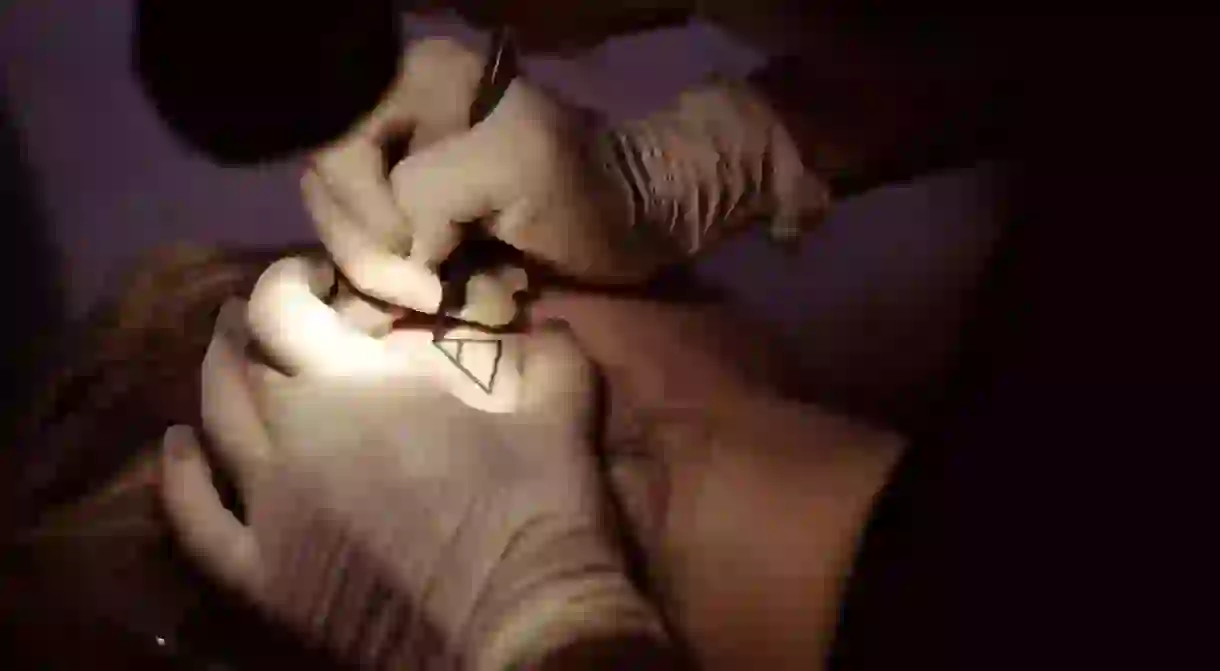The Changing Status of Tattoos in Vietnamese Society

A sign of aristocracy, a means for self-expression, or the unmistakable stamp of a criminal? The social status of permanent ink has differed drastically across history thanks to the ever-changing tides of foreign influence in Vietnam.
Tattoos have long been outside the realm of respectability in Vietnamese society. Popular among gangsters and thugs in the 20th century, permanent ink was seen as the mark of a dangerous man. Nowadays, however, the art form is being slowly but surely embraced and the tattoo industry is thriving in Vietnam’s major cities.
Aristocratic beginnings
Tattoos have long been frowned upon in Vietnam, but it wasn’t always this way. In ancient times, fishermen used to tattoo their entire bodies to resemble a sea monster for protection against aquatic predators. During the Ly and Tran dynasty, tattoos became an official entry requirement for the imperial court. Body art was a hallmark of the aristocracy, and thus highly sought after; the more decorated a person was, the higher their rank and status appeared to be. This was true for both genders, although women tended to opt for flowers and birds, while men usually chose powerful beasts, like snakes and tigers.
A bad reputation
The popularity of tattoos declined after the Ming occupation in 1407 and the stylish, ornamental body art of the Ly and Tran dynasty faded away. However, it wasn’t until the French occupation in the 19th century that tattoos well and truly gained a bad reputation. French colonists brought over the practice of inking codes upon prisoners in order to identify them, rendering tattoos as the stamp of wrongdoers, and certainly not an art form.
In 1940, the Japanese army entered Vietnam, beginning an occupation that lasted until their World War II defeat in 1945. During this time, Irezumi tattoos became popular amongst prisoners. Tattoos were reclaimed by those on the wrong side of the law, and gang members and prostitutes began to give themselves intricate, colourful pieces as a way of recognising one another. Tattoos became a means of expression, instead of something that was forced upon them by the hand of the law.
Nonetheless, the perception of tattoos remained profoundly negative. Organised crime dominated Saigon in the late 20th century and, although tattoos were now more aesthetically pleasing than they had been in the past, they were inextricably linked to the criminal underworld. Body ink was something to be feared or, at the very least, a sure sign that somebody was up to no good.
Changing attitudes
Around the turn of the millennium, things began to change. Ho Chi Minh City’s first tattoo parlour, Saigon Ink, was opened in 2004 by Danis Nguyen, who is now internationally recognised for his art. At first, he was treated with suspicion by the authorities but his business has gone from strength to strength, proving popular with tourists and locals alike.
Nowadays, there’s a myriad of places to get inked in any given city. Despite this, and the younger generation embracing tattoos as an art form, the stigma lingers and is often the cause of familial conflict.
Thao Nguyen says that although her parents’ reaction was “quite chill”, it wasn’t so easy when it came to her extended family. “In Vietnamese culture the family is always close and they got stressed. They talked with my mum and [claimed she was] a bad parent to raise me like that.” After hearing their reactions, Thao says her mother “started to worry about what neighbours think about me with my tattoos”.

Some have resorted to simply pulling the wool over their parents’ eyes. “I hid [my tattoo] from my mum for six months and always told her it’s a temp,” says Hannah Ng, who lives in Saigon. “To this day, it’s been two years and she still tells me to rub it off.”
“Most people get tattoos that they can hide,” agrees Camille, a tattooist who owns a studio in the Thao Dien neighbourhood. Similarly, Thao covers her tattoos at work and family events but explains “I don’t mind doing that. It’s fun, like I have two different lives”.

Gender bias
There also appears to be a significant amount of gender bias around tattoos and who should be giving them.
“A lot of times when Vietnamese people ask me what I do and I say that I tattoo, they tell me ‘but you are a girl!’” laughs Camille. “For them, it’s more of a man’s job.”

Young women like Thao, however, are fighting hard against this perception. “Life is just too short to worry about what people think about you,” she insists. “ I just keep doing what I think is right and help people whenever I can.”
Onwards and upwards
Although tattoos continue to be a point of contention in many families, the explosion of tattoo parlours across the country and surging popularity of body ink suggests this attitude might soon be a thing of the past.
Indeed, familial disapproval is certainly not always the case. “I had an encounter with a customer that came with her mum,” Camille recounts. “Her mum was this very sweet lady and she was glad her daughter was getting a tattoo and wanted to see it done. It was a “family” tattoo.”
Similarly, things have certainly changed in the service industry. In many bars and restaurants that cater to a young or tourist crowd it’s common to see tattooed waiters and bartenders. Inked staff is now a sign that you’re somewhere trendy and youthful, rather than a gangster’s den.
Although the stigma around tattoos in Vietnam has not totally disappeared, attitudes today are much more relaxed than in the past. The tattoo industry is booming and safety standards are higher than ever. Tattooed tourists certainly need not worry about visiting Vietnam, or having more ink done while they’re here.













